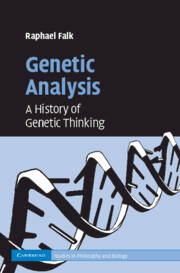Book contents
- Frontmatter
- Contents
- List of figures
- Acknowledgments
- Introduction
- PART I FROM REPRODUCTION AND GENERATION TO HEREDITY
- PART II FAKTOREN IN SEARCH OF MEANING
- PART III THE CHROMOSOME THEORY OF INHERITANCE
- PART IV GENES AS THE ATOMS OF HEREDITY
- PART V INCREASING RESOLVING POWER
- 11 Recruiting bacteria and their viruses
- 12 Molecular “cytogenetics”
- 13 Recombination molecularized
- PART VI DEDUCING GENES FROM TRAITS, INDUCING TRAITS FROM GENES
- PART VII WHAT IS TRUE FOR E. COLI IS NOT TRUE FOR THE ELEPHANT
- Concluding comments
- Bibliography
- Index
13 - Recombination molecularized
Published online by Cambridge University Press: 07 August 2009
- Frontmatter
- Contents
- List of figures
- Acknowledgments
- Introduction
- PART I FROM REPRODUCTION AND GENERATION TO HEREDITY
- PART II FAKTOREN IN SEARCH OF MEANING
- PART III THE CHROMOSOME THEORY OF INHERITANCE
- PART IV GENES AS THE ATOMS OF HEREDITY
- PART V INCREASING RESOLVING POWER
- 11 Recruiting bacteria and their viruses
- 12 Molecular “cytogenetics”
- 13 Recombination molecularized
- PART VI DEDUCING GENES FROM TRAITS, INDUCING TRAITS FROM GENES
- PART VII WHAT IS TRUE FOR E. COLI IS NOT TRUE FOR THE ELEPHANT
- Concluding comments
- Bibliography
- Index
Summary
Most geneticists believe in crossing over, that is to say breakage of two chromosomes at homologous points followed by exchange. This process has generally been thought of in mechanical terms. It is at least equally fruitful to think of it in chemical terms.
Haldane (1954, 110)When recombination was observed in bacteria, Lederberg re-evoked the old idea of copy-choice that Belling (1928) and Freese (1957) had suggested, proposing that it could also be extended to eukaryotic chromosomes in order to overcome abnormalities such as gene conversion (see Chapter 6): If daughter chromatids were formed by conservative replication, then a copy-choice mechanism might switch synthesis from one chromatid to another, and if the synthesis of the two daughter chromatids from each parental chromosome was not quite synchronized, both might be copied over a short interval from the same parent, thereby giving rise to a 3:1 ratio at a heterozygous site. Replicas can switch from copying off one chromosome to copying off the other repeatedly in short regions of effective pairing, and the switching need not be reciprocal, resulting in both gene conversion and negative interference (Holliday, 1964; Whitehouse, 1965, 317). However, as noted earlier (Chapter 5), there were serious experimental inconsistencies with any copy-choice model of eukaryotic chromosome replication: The model predicted recombination between only the two replicated daughter chromatids, ignoring the fact that all possible pairs of the four chromatids may be involved in crossing-over events; chromosome replication occurred at the S-phase of the cell cycle, prior to meiosis and to its chromosome pairing (Swift, 1950); and this replication of the DNA was semi-conservative (Taylor, 1959).
- Type
- Chapter
- Information
- Genetic AnalysisA History of Genetic Thinking, pp. 202 - 208Publisher: Cambridge University PressPrint publication year: 2009



